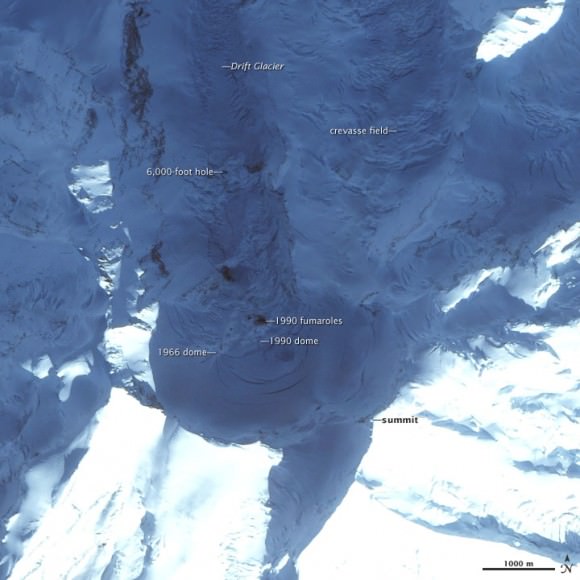

Redoubt volcano crater showing rapidly melting glacier and enlarged "ice piston" feature. Picture Date: March 21, 2009 Image Creator: Cyrus Read, Image courtesy of AVO/USGS.
[/caption]
Overnight, Alaska’s Redoubt volcano erupted with five large explosions. The National Weather Service has issued an Ashfall Advisory, with light ashfall already reported in some regions. Located about 100 miles southwest of Anchorage, Redoubt’s last eruption occurred in 1989-1990, causing widespread mudfalls or “lahars” and coated Anchorage and other nearby areas with ash. The ash affected air traffic as far south as Texas. Redoubt’s 3,108-meter (10,197-foot) peak has been belching steam for several weeks, with seismologists anticipating a possible eruption. Visible evidence of increased volcanic activity appeared at the alaska volcano summit from late January through February. Holes appeared in the ice, and streams of melt water cut across the surface of the Drift Glacier on Redoubt’s north flank.
The four explosions were recorded at 10:38 pm and 11:02 pm local time on March 22, and then at 2:14 am, 1:39 am and 4:37 am local time on March 23.
An Ashfall Advisory for the Susitna Valley means that all will likely be deposited there, and residents are advised to seal windows and doors, protect electronics and cover air intakes and open water supplies.


Source: Alaska Volcano Observatory, NASA’s Earth Observatory
Chemical rockets are loud, noisy and can only get us so far. If we want…
Any satellite sent to space must be able to deal with the battle with Earth's…
NASA's asteroid-studying spacecraft Lucy captured an image of its next flyby target, the asteroid Donaldjohanson.…
If you've ever looked at Mars through a telescope, you probably noticed its two polar…
Our Solar System is in motion and cruises at about 200 kilometres per second relative…
Late is better than never for the ‘Blaze Star’ T Coronae Borealis. It was on…